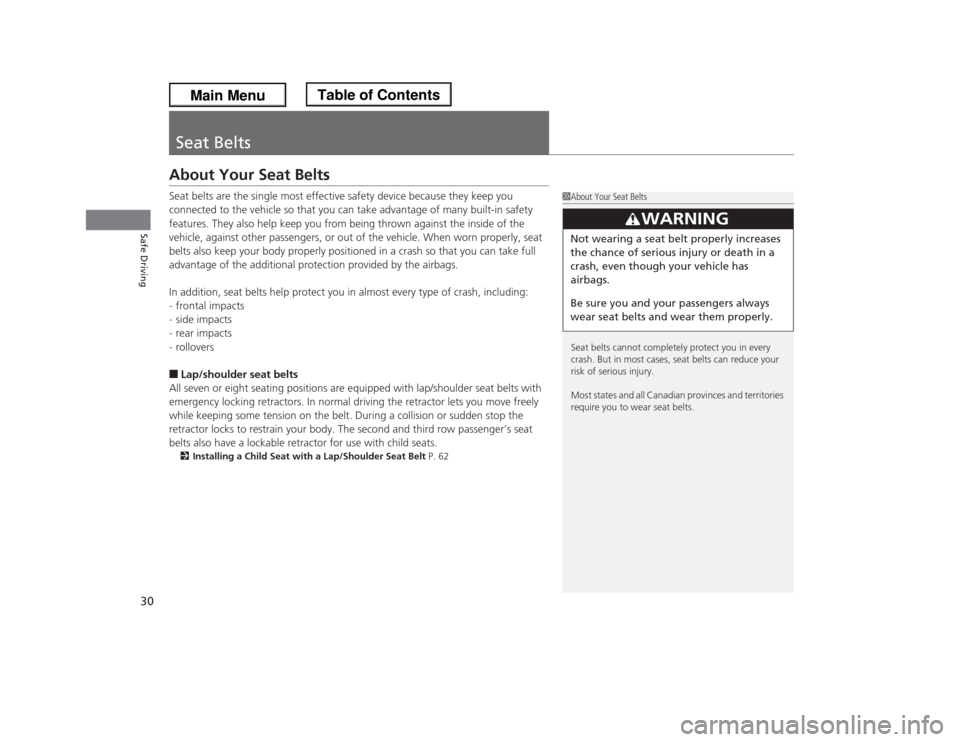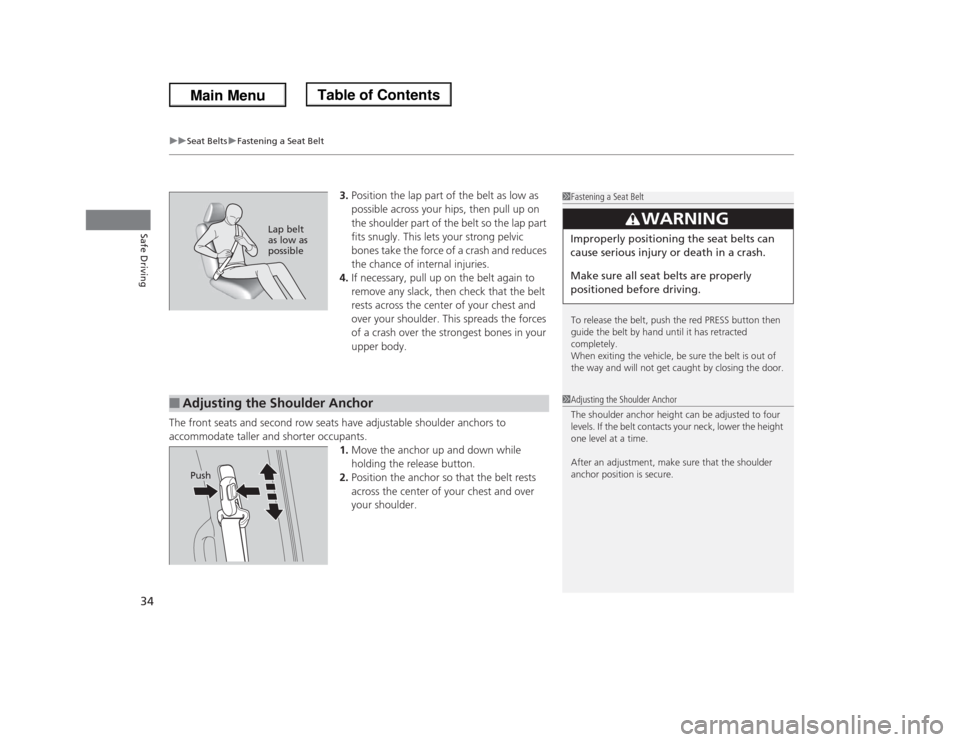Page 6 of 433
5Quick Reference Guide
❙Sun Visors❙Vanity Mirrors❙Moonroof Switch
* (P139)
❙Map Lights
(P169)
❙HomeLink® Button
* (P252)
❙Sunglasses Holder
(P179)
❙Seat Belts
(P30)
❙Grab Handle❙Coat Hooks
(P177)
❙Seat Belt to Secure a Child Seat
(P64)
❙Seat Belt (Installing a Child Seat)
(P62)
❙Accessory Power Socket
(P175)
❙Side Curtain Airbags
(P49)
❙Coat Hooks
(P177)
❙AC Power Outlet
* (P176)
❙Auxiliary Input Jacks
* (P236)
❙Side Airbags
(P46)
❙Second Row Seat
(P154, 161)
❙Front Seat
(P153)
❙Removable Center Console
* (P170)
❙Flip-up Trash Bag Ring
* (P171)
❙Third Row Seat
(P154, 161)
❙Folding the One-Motion Third Row Magic Seat
(P165)
❙Second Row Multi-Functional Center Seat
* (P154, 164)
❙Integrated Sunshades
* (P181)
* Not available on all models
Page 20 of 433
Quick Reference Guide19
Handling the Unexpected
(P381)
Flat Tire
(P383)
●Park in a safe location and replace the
flat tire with the compact spare tire in
under the floor between the front seats
and the second row seats.
Indicators Come On (P 398)
●Identify the indicator and consult the
owner's manual.
Engine Won't Start (P392)
●If the battery is dead, jump start using a
booster battery.Blown Fuse
(P403)
●Check for a blown fuse if an electrical
device does not operate.
Overheating
(P396)
●Park in a safe location. If you do not see
steam under the hood, open the hood,
and let the engine cool down.
Emergency Towing (P409)
●Call a professional towing service if you
need to tow your vehicle.
Page 31 of 433

30Safe Driving
Seat BeltsAbout Your Seat BeltsSeat belts are the single most effective safety device because they keep you
connected to the vehicle so that you can take advantage of many built-in safety
features. They also help keep you from being thrown against the inside of the
vehicle, against other passengers, or out of the vehicle. When worn properly, seat
belts also keep your body properly positioned in a crash so that you can take full
advantage of the additional protection provided by the airbags.
In addition, seat belts help protect you in almost every type of crash, including:
-frontal impacts
-side impacts
-rear impacts
-rollovers■Lap/shoulder seat belts
All seven or eight seating positions are equipped with lap/shoulder seat belts with
emergency locking retractors. In normal driving the retractor lets you move freely
while keeping some tension on the belt. During a collision or sudden stop the
retractor locks to restrain your body. The second and third row passenger’s seat
belts also have a lockable retractor for use with child seats.2Installing a Child Seat with a Lap/Shoulder Seat Belt P. 62
1About Your Seat Belts
Seat belts cannot completely protect you in every
crash. But in most cases, seat belts can reduce your
risk of serious injury.
Most states and all Canadian provinces and territories
require you to wear seat belts.
3
WARNING
Not wearing a seat belt properly increases
the chance of serious injury or death in a
crash, even though your vehicle has
airbags.
Be sure you and your passengers always
wear seat belts and wear them properly.
Page 35 of 433

uuSeat BeltsuFastening a Seat Belt
34Safe Driving
3.Position the lap part of the belt as low as
possible across your hips, then pull up on
the shoulder part of the belt so the lap part
fits snugly. This lets your strong pelvic
bones take the force of a crash and reduces
the chance of internal injuries.
4.If necessary, pull up on the belt again to
remove any slack, then check that the belt
rests across the center of your chest and
over your shoulder. This spreads the forces
of a crash over the strongest bones in your
upper body.
The front seats and second row seats have adjustable shoulder anchors to
accommodate taller and shorter occupants.
1.Move the anchor up and down while
holding the release button.
2.Position the anchor so that the belt rests
across the center of your chest and over
your shoulder.
1Fastening a Seat Belt
To release the belt, push the red PRESS button then
guide the belt by hand until it has retracted
completely.
When exiting the vehicle, be sure the belt is out of
the way and will not get caught by closing the door.
3
WARNING
Improperly positioning the seat belts can
cause serious injury or death in a crash.
Make sure all seat belts are properly
positioned before driving.
Lap belt
as low as
possible
■
Adjusting the Shoulder Anchor
1Adjusting the Shoulder Anchor
The shoulder anchor height can be adjusted to four
levels. If the belt contacts your neck, lower the height
one level at a time.
After an adjustment, make sure that the shoulder
anchor position is secure.
Push
Page 37 of 433
uuSeat BeltsuFastening a Seat Belt
36Safe Driving
3.Insert the latch plate into the buckle.
Properly fasten the seat belt the same way
you fasten the lap/shoulder seat belt.
1Seat Belt with Detachable Anchor
To unlatch the detachable anchor, insert a key into
the slot on the side of the anchor buckle.
Pivot down the anchor buckle forward.
Insert a key into the slot on the back of the anchor
buckle.Second row center seat
Buckle
Latch
Plate
Page 60 of 433
59
uuChild SafetyuSafety of Infants and Small Children
Continued
Safe Driving
A LATCH-compatible child seat can be installed in each of the second and third row
seats. A child seat is attached to the lower anchors with either the rigid or flexible
type of connectors.
1.Locate the lower anchors under the marks.■
Installing a LATCH-Compatible Child SeatMarks
Marks
Third row seatSecond row seat
Page 61 of 433
uuChild SafetyuSafety of Infants and Small Children
60Safe Driving
2.Place the child seat on the vehicle seat then
attach the child seat to the lower anchors
according to the instructions that came
with the child seat.
uWhen installing the child seat, make sure
that the lower anchors are not
obstructed by the seat belt or any other
object.
To install a LATCH-compatible child seat in
the second row center seat, remove the
covers on each lower end of the seat -back
by pulling on the handles.
1Installing a LATCH-Compatible Child Seat
For your child's safety, when using a child seat
installed using the LATCH system, make sure that the
seat is properly secured to the vehicle. A child seat
that is not properly secured will not adequately
protect a child in a crash and may cause injury to the
child or other vehicle occupants.
Rigid Type
Lower Anchors
Flexible Type
Lower Anchors
Handle Marks Cover
Second row center seat
Page 62 of 433
61
uuChild SafetyuSafety of Infants and Small Children
Continued
Safe Driving
3.Raise the head restraint to its highest
position, then route the tether strap
between the head restraint legs, and secure
the tether strap hook onto the anchor.
4.Tighten the tether strap as instructed by the
child seat maker.
5.Make sure the child seat is firmly secured by
rocking it forward and back and side to
side; little movement should be felt.
6.Make sure any unused seat belt that a child
can reach is buckled, the lockable retractor
is activated, and the belt is fully retracted
and locked.
Anchor
Tether Strap Hook
Anchor
Tether
Strap
HookSecond row center seatSecond row outer position